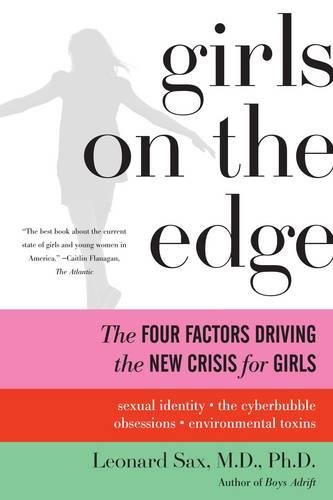- Visitor:18
- Published on:
Going beyond gender stereotypes
Lack of awareness about gender differences disadvantages both girls and boys. Acknowledging innate tendencies and gender differences in men and women can help dismantle gender stereotypes. How? Read this excerpt from Leonard Sax’s book.

Experiment: Monkeys, girls, boys, and toys. (1)
Developmental psychologist Gerianne Alexander thinks she might know. Professor Alexander was the first to offer monkeys a choice of playing with “boy toys” or “girl toys.” Like Dr. Wallen’s group, Alexander found sex differences among monkeys that are similar to the sex differences we see among human children. (2)
In 2003, one year after she published her monkey study, Alexander published her theory explaining why female and male monkeys—as well as female and male humans—might prefer to play with different toys. (3)
Scientists have known for roughly three decades that our visual system actually comprises two separate systems operating in parallel, beginning at the level of the ganglion cells in the retina and extending back to visual cortex and visual association cortex. (4) One system is devoted to answering the question “What is it? —what’s its color, what’s its texture?” The other system is devoted to answering the question “Where is it going? —and how fast is it moving?” These two systems in the brain are often referred to as the “what” system and the “where” system. (5)
Professor Alexander was the first to suggest that hardwired sex differences in the visual system may explain the observed sex differences in the toy preferences of children as well as monkeys. She conjectured that maybe girls have more resources in the “what” system and boys have more resources in the “where” system. Her hypothesis accommodates a number of findings that otherwise are hard to explain: for example, that baby girls aged 3 to 8 months, but not baby boys, prefer to look at dolls rather than toy trucks. (6)

Researchers in Germany recently reported dramatic sex differences in the anatomy of human visual cortex in adults, with more resources devoted to the “where” system in men compared with women. (7)
That finding also fits Alexander’s suggestion. Professor Alexander’s hypothesis helps me understand the gender differences I have seen firsthand, in schools from Edinburgh to Calgary to Dallas to Auckland, in gender-specific best practice for teaching not only physics, but also creative writing, visual arts, and even modern foreign languages. The best way to teach physics to boys is pretty much the way we usually do teach physics in coed classrooms: with a focus on action— cars accelerating, football players colliding, and so on, which engages the “where is it going?” system.
The best way to teach physics to girls appears to be to focus on answers to questions like: What is it? What is light made out of? What is matter made out of? What laws govern the universe? Why those laws and not others?
How we see influences how we perceive the world and what we like to read and how we like to write, particularly when we are young. In my book, Boys Adrift, I explored how a lack of awareness of this point disengages boys in subjects such as creative writing and visual arts. Some boys want to write stories with an emphasis on action, but they lose their enthusiasm when the teacher says, “Tell me more about your characters, Justin: What do they look like? What kind of clothes are they wearing?” The teacher wants Justin to emphasize the features that engage the “what” visual system, but Justin wants to tell a story that engages the “where” visual system.
Most teachers don’t know anything about sex differences in the visual system. Very few schools of education provide any instruction on this topic, or on anything related to sex differences in best practice for teaching various subjects. (8)
The general lack of awareness of gender differences disadvantages both girls and boys. The result too often is a school where the boys think creative writing is for girls, while the girls believe that physics is for guys. When teachers do understand these gender differences, you can break down gender stereotypes. As Jenn Alabaster and others have found, girls love physics if you know how to teach it to them.
References:
1. I have borrowed the title of this section from Melissa Hines and Gerianne Alexander, “Monkeys, girls, boys and toys,” Hormones and Behavior, volume 54 (2008), pp. 478–479.
2. Gerianne Alexander and Melissa Hines, “Sex differences in response to children’s toys in non-human primates,” Evolution and Human Behavior, volume 23 (2002), pp. 467–479.
3. Gerianne Alexander, “An evolutionary perspective of sex-typed toy preferences: pink, blue, and the brain,” Archives of Sexual Behavior, volume 32 (2003), pp. 7–14.
4. Leslie Ungerleider and Mortimer Mishkin are the neuroscientists most often credited for being the first—in the early 1980s—to recognize explicitly the anatomical distinction between the “what” system and the “where” system. See, for example, their paper (co-written with Kathleen Macko) entitled “Object vision and spatial vision: two cortical pathways,” Trends in Neuroscience, volume 6 (1983), pp. 414–417.
5. For a more recent review of this literature, see Melvyn Goodale and David Westwood, “An evolving view of duplex vision: separate but interacting cortical pathways for perception and action,” Current Opinion in Neurobiology, volume 14 (2004), pp. 203–211.
6. Gerianne Alexander, Teresa Wilcox, and Rebecca Woods, “Sex differences in infants’ visual interest in toys,” Archives of Sexual Behavior, volume 38 (2009), pp. 427–433. For more information on sex differences in the vision of babies, see Anna Horwood and Patricia Riddell, “Gender differences in early accommodation and vergence development,” Ophthalmic and Physiological Optics, volume 28 (2009), pp. 115–126.
7. Katrin Amunts and colleagues, “Gender-specific left-right asymmetries in human visual cortex,” Journal of Neuroscience, volume 27 (2007), pp.1356–1364, online at www.jneurosci.org/cgi/content/full/27/6/1356.
8. At most schools of education, it’s politically incorrect even to suggest that best practice for teaching the subject areas might be different for girls compared with boys. Two notable exceptions to this unfortunate rule are Stetson University in Deland, Florida, and the University of Nevada at Reno.
[Source: Leonard Sax, Girls on the edge: the four factors driving the new crisis for girls: sexual identity, the cyberbubble, obsessions, environmental toxins. New York : Basic Books, 2010. p. 140-142.]
Center for Indic Studies is now on Telegram. For regular updates on Indic Varta, Indic Talks and Indic Courses at CIS, please subscribe to our telegram channel !
- 9 min read
- 0
- 0










